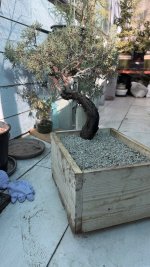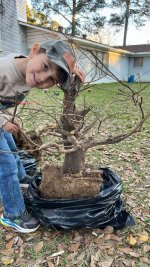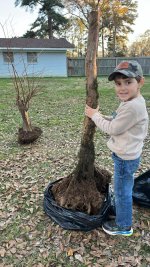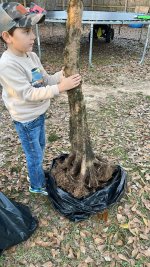You are using an out of date browser. It may not display this or other websites correctly.
You should upgrade or use an alternative browser.
You should upgrade or use an alternative browser.
The 2024 Yamadori/Collecting Thread
- Thread starter Cajunrider
- Start date
Hartinez
Masterpiece
Good collects. I dug a native hackberry not too long ago. Native to New Mexico. Celtis Reticulata. They grow with such a great contorted pattern.Ended up with 4 hornbeams, and 2 hackberries. Really like 1 of the hackberries, it was pretty dwarfed, 4 ft tall, 3 inch base or so, with really nice bark.
View attachment 578265

The Barber
Chumono
Dang, that is nuts how contorted that grows, cool tree!Good collects. I dug a native hackberry not too long ago. Native to New Mexico. Celtis Reticulata. They grow with such a great contorted pattern.
View attachment 578269
The Barber
Chumono
Well, went back out today and did some more digging. I'll get better photos in a bit when I unwrap them and get them potted up. Really amazed at the roots on these guys.
Here's a couple of them
Probably a 4 inch trunk on this American hornbeam, super shallow roots.


American Beech

Hornbeam, has a thick 1 inch root mat.

Here's a couple of them
Probably a 4 inch trunk on this American hornbeam, super shallow roots.


American Beech

Hornbeam, has a thick 1 inch root mat.

Last edited:
Matt3839
Mame
Not collected recently but I grabbed this western juniper a while back and put it in a box with pure pumice. Some small roots in the ball of soil but we’ll see how it does this spring.
Box was made out of some basic Doug fir and I used size 7 strips of embroidery mesh for the bottom and then drilled some screws in to hold it in place.
Box was made out of some basic Doug fir and I used size 7 strips of embroidery mesh for the bottom and then drilled some screws in to hold it in place.
Attachments
RaginCajun
Mame
doc spring _work
Shohin
I really need to plan a trip down to Louisiana here soon... Those bald cypress steal my heart every time I see em, the ones around here have zero characterMy son and I collected these 3 bald cypress New Year’s Day 2025.
DeepSouth
Mame
It seems that there are lots of us here from Louisiana. I wonder why?
Perhaps it's the fact that our landscape is dominated by trees, many of which are quite awe-inspiring (BC swamps, massive live oaks, etc.)? This isn't the best place in the country for growing bonsai, by any means. The intense humidity and heat of the summer can be challenging, particularly with regards to fungal issues.
Perhaps it's the fact that our landscape is dominated by trees, many of which are quite awe-inspiring (BC swamps, massive live oaks, etc.)? This isn't the best place in the country for growing bonsai, by any means. The intense humidity and heat of the summer can be challenging, particularly with regards to fungal issues.
doc spring _work
Shohin
Hmm yes I agree too much humidity could possibly be a problem but given y'all's zone id imagine the longer growing season helps, I know that most of the west past y'all isnt prime for bonsai (or much plants in gen) I think Washington and calli are the exception to that... But yeah I've noticed a lot of y'all in Louisiana and generally the East not much over here in the Midwest...It seems that there are lots of us here from Louisiana. I wonder why?
Perhaps it's the fact that our landscape is dominated by trees, many of which are quite awe-inspiring (BC swamps, massive live oaks, etc.)? This isn't the best place in the country for growing bonsai, by any means. The intense humidity and heat of the summer can be challenging, particularly with regards to fungal issues.
RaginCajun
Mame
And also perhaps the Greater New Orleans Bonsai Society.. it’s one of the oldest and most active bonsai society’s in the US. John Naka was highly involved with them back in the day. I haven’t met anyone in the hobby up here in the north, but bonsai is very popular in south Louisiana.It seems that there are lots of us here from Louisiana. I wonder why?
Perhaps it's the fact that our landscape is dominated by trees, many of which are quite awe-inspiring (BC swamps, massive live oaks, etc.)? This isn't the best place in the country for growing bonsai, by any means. The intense humidity and heat of the summer can be challenging, particularly with regards to fungal issues.
Cmd5235
Chumono
Wow, the first and third ones will be stunners! Love the material, I am jealous!My son and I collected these 3 bald cypress New Year’s Day 2025.
DeepSouth
Mame
I have only been back in Louisiana for a couple of years, so haven't joined any of the clubs yet. I do plan to join GNOBS this year, I have heard great things.And also perhaps the Greater New Orleans Bonsai Society.. it’s one of the oldest and most active bonsai society’s in the US. John Naka was highly involved with them back in the day. I haven’t met anyone in the hobby up here in the north, but bonsai is very popular in south Louisiana.
RaginCajun
Mame
I really need to plan a trip down to Louisiana here soon... Those bald cypress steal my heart every time I see em, the ones around here have zero
They are very active.. they have several ongoing development projects. Check out their Facebook. Randy Bennett who is the king of bald cypress bonsai, has been leading the GNOBS trident study group. The trees are planted on tiles in the ground at Underhill bonsai nursery. They go out as a club together three times a year. They dig them up annually to work the nebari.. prune some then stick em back in the ground.. they return to do some pruning and defoliation later in the growing season and then again in the fall for pruning.I have only been back in Louisiana for a couple of years, so haven't joined any of the clubs yet. I do plan to join GNOBS this year, I have heard great things.
Tallasthetrees
Seed
- Messages
- 2
- Reaction score
- 2
Were you able to collect these in one shot or did you have to root prune for a few years to get enough feeder roots near the base? I've heard you have to do that with these two species and, in my experience, they usually don't have many feeder roots near the base.Well, went back out today and did some more digging. I'll get better photos in a bit when I unwrap them and get them potted up. Really amazed at the roots on these guys.
Here's a couple of them
Probably a 4 inch trunk on this American hornbeam, super shallow roots.
View attachment 578319View attachment 578318
American Beech
View attachment 578321
Hornbeam, has a thick 1 inch root mat.
View attachment 578324
Goodbrake
Mame
I suppose this out to go here, though my documentation is rather belated. On Oct 30th 2024 I collected this small cedar elm while walking my dog using just my pocket knife, carrying the root ball back in my hand. It's leafing out now, and will probably be repotted next spring to change the planting angle.




The Barber
Chumono
The soil is very sandy rich bottomland topsoil in that area, so the roots are dense and close to the trunk on the trees in the collection area. The roots are typically similar to this one. Basically pot ready roots. They also get cut way back so there really isn't any real demand on the roots like there would be if you dealing with say a fully developed bonsai. I've had success with hornbeams that were pretty lacking in feeder roots. I planted last years hornbeams into a 3 parts pumice, 1 part super fine peat mix. I only had 1 die out of 20ish, and it was a very large one with very few feeder roots. Hornbeams like their feet to stay moist, so the added peat helps hold added moisture.Were you able to collect these in one shot or did you have to root prune for a few years to get enough feeder roots near the base? I've heard you have to do that with these two species and, in my experience, they usually don't have many feeder roots near the base.
Beech on the other hand, they can do alright with less roots than you'd think, but I have my best luck potting them into a 1-1-1 kanuma, lava, pumice mix, or a 1-2 kanuma, pumice mix would do well I'm sure. They love acidic soil.
Luckily the elms in the areas I collect from are the species with the worst roots, instead of the other species. Not to say I don't wish they had great roots. Elms can take some major abuse, and can survive the loss of almost off of their roots. Aside from completely drying out and Dutch elm disease of course. I pot Elms into 100 percent pumice.
You'll find that digging younger material, the roots tend to be closer. Large trees with large roots generally have the roots pushed far from the trees as the demand for more stability grows, and the feeders tend to be connected further out on those large roots.
Here's what the roots look like in the area I collect in.

Joe Dupre'
Masterpiece
That's about as good as it gets. Lucky find.The soil is very sandy rich bottomland topsoil in that area, so the roots are dense and close to the trunk on the trees in the collection area. The roots are typically similar to this one. Basically pot ready roots. They also get cut way back so there really isn't any real demand on the roots like there would be if you dealing with say a fully developed bonsai. I've had success with hornbeams that were pretty lacking in feeder roots. I planted last years hornbeams into a 3 parts pumice, 1 part super fine peat mix. I only had 1 die out of 20ish, and it was a very large one with very few feeder roots. Hornbeams like their feet to stay moist, so the added peat helps hold added moisture.
Beech on the other hand, they can do alright with less roots than you'd think, but I have my best luck potting them into a 1-1-1 kanuma, lava, pumice mix, or a 1-2 kanuma, pumice mix would do well I'm sure. They love acidic soil.
Luckily the elms in the areas I collect from are the species with the worst roots, instead of the other species. Not to say I don't wish they had great roots. Elms can take some major abuse, and can survive the loss of almost off of their roots. Aside from completely drying out and Dutch elm disease of course. I pot Elms into 100 percent pumice.
You'll find that digging younger material, the roots tend to be closer. Large trees with large roots generally have the roots pushed far from the trees as the demand for more stability grows, and the feeders tend to be connected further out on those large roots.
Here's what the roots look like in the area I collect in.
View attachment 586428
Tallasthetrees
Seed
- Messages
- 2
- Reaction score
- 2
Thanks for the info!The soil is very sandy rich bottomland topsoil in that area, so the roots are dense and close to the trunk on the trees in the collection area. The roots are typically similar to this one. Basically pot ready roots. They also get cut way back so there really isn't any real demand on the roots like there would be if you dealing with say a fully developed bonsai. I've had success with hornbeams that were pretty lacking in feeder roots. I planted last years hornbeams into a 3 parts pumice, 1 part super fine peat mix. I only had 1 die out of 20ish, and it was a very large one with very few feeder roots. Hornbeams like their feet to stay moist, so the added peat helps hold added moisture.
Beech on the other hand, they can do alright with less roots than you'd think, but I have my best luck potting them into a 1-1-1 kanuma, lava, pumice mix, or a 1-2 kanuma, pumice mix would do well I'm sure. They love acidic soil.
Luckily the elms in the areas I collect from are the species with the worst roots, instead of the other species. Not to say I don't wish they had great roots. Elms can take some major abuse, and can survive the loss of almost off of their roots. Aside from completely drying out and Dutch elm disease of course. I pot Elms into 100 percent pumice.
You'll find that digging younger material, the roots tend to be closer. Large trees with large roots generally have the roots pushed far from the trees as the demand for more stability grows, and the feeders tend to be connected further out on those large roots.
Here's what the roots look like in the area I collect in.
View attachment 586428
Ja_De 2.0
Seedling
Surfing this thread and saw your post... The 2nd to last beech tree is really awesome!!! I've seen giant broken and hollow beech trees during my time as a logger... Your tree appeared to be almost ancient at the time it was photographed. Any chance of a recent picture you'd care to share ?Oooo, how'd I miss this thread...
New Years Day, went for a walk in the woods
Wasn't 100 percent sure on this one, possibly red maple, of which I haven't played with, so grabbed it.
View attachment 524069
View attachment 524070
Oak
View attachment 524071
Beech, didn't snap a photo of it post dig, nebari wasn't anything special, though it had a ton of feeder roots.
View attachment 524072
Another American Beech pair, haven't dug them yet, but note worthy I thought, nice movement. May give them a couple years, they are 100 yards from the house.
View attachment 524073
December 26th Collections, close enough to 2024 they'll get dropped in here as well.
Eastern hemlock, grabbed 2, usually they are straight trunked and uninteresting, but these had movement and health.
View attachment 524074
View attachment 524075
And this American Beech. One worth crying over if it doesn't make it I figure. I really love the potential. It will be going on a heat bed, hopefully it will help it to develop roots over the winter in my heavily insulated shed.
It was rooted over a chunk of loose rock in shallow soil...I had this 22 inch pot I wasn't using so it went in there. It was dumping rain by the time I got home,and about half way through collection it was a solid drizzle, so I opted to not build a wooden box for it as rain was blowing into the porch and my treated deck boards I use to make boxes was all drenched.
I wish I had taken a picture of the root system, probably a fist sized amount of feeder roots total, mostly near the trunk on the opposite side of the rock, it was on the ledge of a 6 ft ledge of a cutout in a logging road. Soil is 1-1-1 kanuma, Lava rock, and pumice.
View attachment 524079
View attachment 524077View attachment 524076
And this one I left for later, the guy has been chopped back repeatedly to leave a view of the creek behind it.
View attachment 524078
The Barber
Chumono
It was the only beech I collected last year that didn't push in the spring sadly. Although I know where one is that is almost identical. Sadly the other is on the edge of a 20 foot embankment that has eroded leaving half the roots super long and leggy. Beavers pruned this one.Surfing this thread and saw your post... The 2nd to last beech tree is really awesome!!! I've seen giant broken and hollow beech trees during my time as a logger... Your tree appeared to be almost ancient at the time it was photographed. Any chance of a recent picture you'd care to share ?

Similar threads
- Replies
- 1
- Views
- 750
- Replies
- 6
- Views
- 197
- Replies
- 0
- Views
- 262







